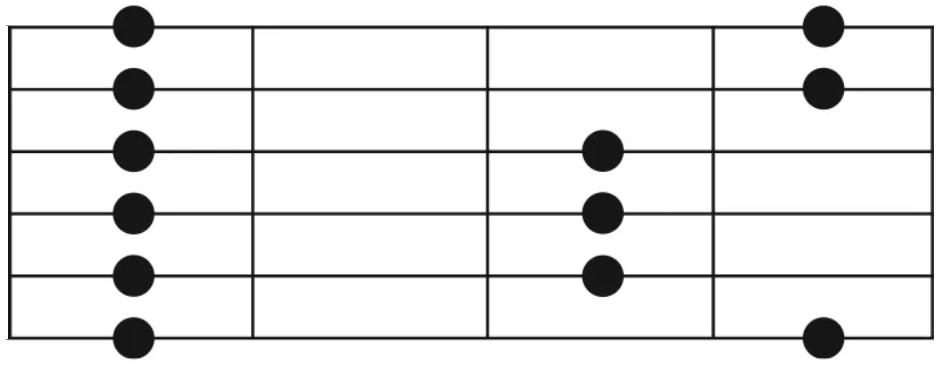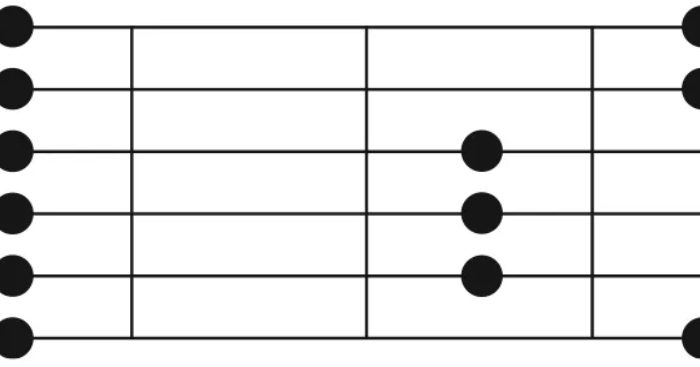I learned early on how to solo in a major key. Like just about everyone (so it seems) who wants to play solos on guitar, I learned the minor pentatonic scale first. Specifically, I learned Box 1 of the minor pentatonic scale.

This particular scale is presented as the magic key to playing guitar solos. I came to believe that it worked on all songs. Even songs in major keys. If you wanted to solo, just play the notes of the minor pentatonic scale and you’d be golden.
Need help understanding the pentatonic scales? Check out these two articles:
Playing solo on guitars is a bit more complicated than that
Well, it turns out that soloing is not quite so easy as just learning a pattern of five notes of the scale. While it’s true that heroes with guitars all across time and the world have made amazing music with the pentatonic scale, there’s more to it than just knowing those notes in a pattern.
Of course, years are spent learning how to play solos and then mastering the technique. And, like so many other players, I’m still on that journey.
I can play some lead guitar, and maybe some of it doesn’t sound half bad. I even know how to solo in a major key…sometimes (more on that in a moment). But I’m still learning. Always learning!
When the minor pentatonic lets you down
I don’t mean to take anything away from the minor pentatonic scale. Lead guitarists really do use it to make screaming solos on guitar and other instruments. But, despite what I first thought upon learning the scale, it’s not the final answer to all guitar solos.
It wasn’t long after I became familiar with the scale and started developing the ability to put a few solos together that I started getting bored with it. I could use it, but I couldn’t make magic with it. Not consistently anyway. Sometimes my solos were simply just…blah.
Worse yet, I quickly discovered there were times when the minor pentatonic scale just didn’t work right, no matter how many guitars I played it on. Specifically, it didn’t sound right most of the time that I tried to use it to play solos over country songs.
I love old-time country songs, and I became increasingly frustrated that I couldn’t play solos that sounded “right” when I played those songs. It wasn’t just country music though. Even some rock and roll songs didn’t click when I played a solo with the minor pentatonic scale.
The knowledge that finally made how to solo in a major key click
Eventually I came to understand that those solos didn’t sound right because the songs were in major keys. It’s confusing because sometimes even though the song is in a major key, the minor pentatonic works just fine for solos.
Maybe there’s a music theory explanation for it, but for me it just came down to a matter of feel. I could just feel it when a minor pentatonic solo worked over a major key song and when it didn’t.
So I began to realize that I needed to play solos using the major scale for some songs. I learned the major scale pattern on guitar–or at least one position of it. I started using that scale to play my solos. And they sounded…dumb. Boring, aimless, disjointed. They certainly weren’t the cool solos I was hoping for.
Don’t know the major scale on guitar? Read this article:
Some notes just didn’t seem to work, even though they were in the scale. I couldn’t figure out why. It began to feel like I’d never learn how to solo in a major key.
The pentatonic scale comes back to the rescue
There had to be a secret I wasn’t privy to. Then one day, someone finally told me that secret: The minor pentatonic scale isn’t the only pentatonic scale. There’s a major pentatonic scale too.
That was amazing news to me at the time! Even more amazing, the major pentatonic scale shape is identical to the minor pentatonic scale shape, so there’s hardly anything new to learn!
The knowledge that finally enabled me to learn how to solo in a major key
Remember, I told you earlier that the guitar is full of relationships. Well, every major key is related to a minor key. It’s all about the relationships!
Without getting too deep into music theory (which would likely only get me into trouble), there’s a concept called the relative minor. Essentially, this means that every major key has a companion minor key that uses the exact same notes for its scale.
Learn more about the concept of relative scales with this article:
For instance, if you sit down at the piano, start with the note C, and play all of the white keys until you get to the next higher C, then you’ve just played the C major scale.
Now, if you start with the note A and play all of the white keys again up to the next A, you’ve just played the A minor scale. Specifically, the natural minor scale in A. Same notes, different scale. The difference is determined by the note you consider to be the root note. The A as opposed to the C, in this case.
And scales work the same way on guitars as on pianos–it’s just easier to visualize it on pianos. Just like on pianos, the C major scale and the A minor scale played on guitars share the exact same notes. They are related. Thus, A minor is the relative minor of C major. Kind of cool, right?
How do you apply the relative minor concept to learn how to solo in a major key?
Now that we know this concept of relative minor, we can extrapolate to understand that the A minor pentatonic scale is identical to the C major pentatonic scale.
Wait. So you mean that if I want to play a solo in C major, I just use the A minor pentatonic scale? Yes. Exactly…almost. That’s mostly true, because the A minor pentatonic is the C major pentatonic. Or, at least they share identical notes. That knowledge was life changing for me when I finally grasped it.
The only trick is to understand that the keys have different root notes. In Box 1 of the A minor pentatonic scale that we’ve been talking about here, the root note is the A note at the fifth fret of the E string. That’s under your first finger if you play the scale in the standard fingering.
And because notes repeat themselves all over the guitar, there are two other A notes in the pattern (as you can see in the following diagram).
In the C major pentatonic scale, the root note on the E string is under your third or fourth finger (depending upon your technique, but from here on I’ll refer to the fourth finger because you really should learn how to use that little guy) at the eighth fret. So when you’re playing in C major, you need to target the C note as your root. In A minor, you target the A note as your root.

How to find the major pentatonic scale for any major key
So, thinking of this conversely, say you want to play a solo in A major. You now know that you can play a pentatonic scale, but where do you play it?
Remember, when you were in the A minor pentatonic scale, your fourth finger falls naturally on the root not of the corresponding major scale–the C major scale.
So, if you want to solo in A major, fret the A at the fifth fret of the E string with your pinky. Your first finger falls naturally at the F# on the second fret of the E string. That’s three frets down from the A. And sure enough, F# is the relative minor of A major.

In other words, to play a solo in a major key using the major pentatonic scale, find the root note of the scale on the E string, place your pinky on that note and from there use the same pattern that you already know as the minor pentatonic scale. As long as you target the note under your pinky as the root, you will be playing in the major scale.
By the way; though this pattern is Box 1 of the minor pentatonic scale, it’s box 5 of the major pentatonic scale. Read the articles I referenced above if you need help getting that straight.
Now you know how to solo in a major key too
Finally understanding this gave me a new lease on life as a lead guitarist. I finally knew how to solo in a major key. Play solos that made sense over songs that wanted major key solos.
So, give it a shot. Before long, you’ll be playing major-key solos too.
And, like me, you have eliminated one more reason to feel compelled to sell your guitars! In fact, since you now know how to solo in a major key for those country songs–and since it’s common knowledge that you can never have too many guitars–it might be time for you to buy a new guitar. After all, we’ve already talked about the Telecaster and its rightful place as the king of country guitars!
Conclusion
While the minor pentatonic scale works for solos in some major-key songs, it doesn’t always. In those cases, you can turn to the major pentatonic scale.
The major pentatonic scale uses the same patterns as the minor pentatonic scale does. You only need to target the appropriate root note.
When you master this, you will quickly learn how to solo in a major key.

Great tip. I’ll give it a try
Thanks!
Sometimes it takes a bit of getting used to landing on the major root note instead of that trusty old minor root, but stick with it. Pretty soon you’ll play a lick that makes you think, “Hey, that wasn’t half bad!” And from there you just get more and more comfortable.
Legitimate life saver. I was just beginning to toy with soloing and writing riffs and this is the absolute best place to start.
You’re too kind, Max! I’m glad you found it useful. This is one reason I love the guitar…there’s always something new to learn!
Just returned to playing with retirement and THIS is life changing ❤️🎼🎵🎹🪕🎸